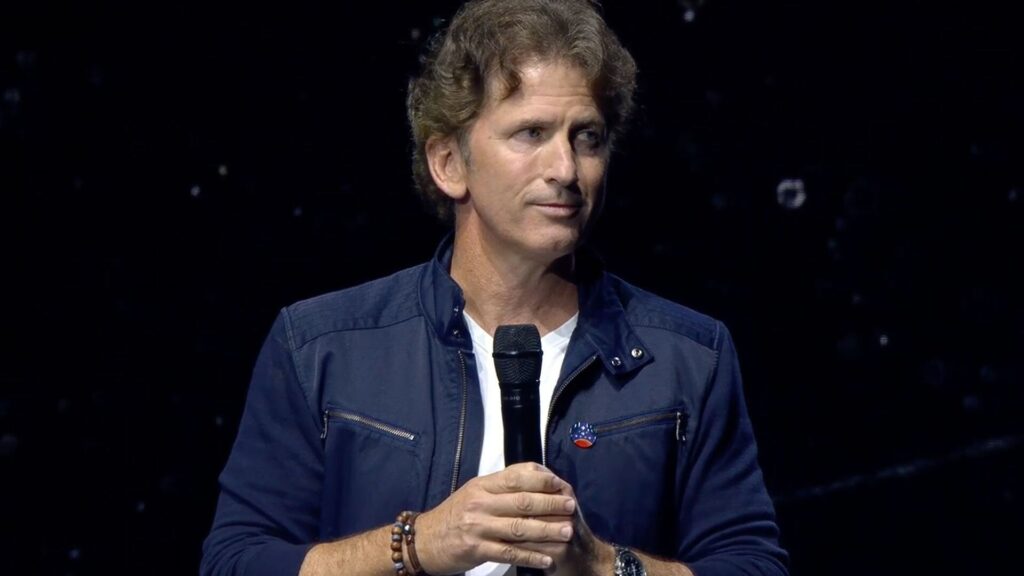

Todd Howard – Crafting Worlds, Shaping Expectations
Todd Howard’s career at Bethesda Softworks isn’t just a series of successful game launches – it’s a story of evolution, adaptation, and an unwavering dedication to creating immersive worlds that players can lose themselves in for years. From the early days of The Elder Scrolls to the sprawling wastelands of Fallout, Howard has played a pivotal role in transforming open-world gaming into what it is today.
But what truly defines Todd Howard’s legacy is not just the games – it’s his ability to listen, adapt, and continually raise the bar, even when that comes with missteps and growing pains. Let’s dive into how Howard’s influence has grown over the years and how his work reflects a deep understanding of fan expectations.
The Early Days – Building Fantasy from the Ground Up
Todd Howard’s early work on The Terminator: Future Shock and Redguard revealed his passion for storytelling and world-building, but it wasn’t until The Elder Scrolls III: Morrowind (2002) that his mark on the industry truly began to take shape.
Morrowind wasn’t just an RPG – it was a revolution in player agency and exploration. Howard envisioned a world that felt alive, reactive, and deeply personal to the player. Its intricate lore, sprawling map, and freedom of choice weren’t just game features – they were a manifesto.
This wasn’t a world you saved in one go; it was a world you lived in.
Morrowind’s success paved the way for Howard to step into the role of lead visionary for Bethesda’s future projects. And as player feedback rolled in, Howard began refining what made Bethesda games stand out – boundless exploration, emergent storytelling, and a sense of limitless possibility.
Oblivion and the Evolution of Player Freedom
Howard’s leadership on The Elder Scrolls IV: Oblivion (2006) marked another significant leap forward. While Morrowind embraced alien landscapes and obscure mechanics, Oblivion took a different route – accessibility without sacrificing depth.
Howard oversaw streamlined mechanics, procedural world-building, and a focus on cinematic storytelling. The game retained the expansive freedom fans adored but packaged it in a way that welcomed new players without alienating veterans.
The result?
- Critical acclaim
- Commercial success
- Oblivion became a gateway RPG for countless new players.
Howard proved that listening to fan feedback and evolving accordingly wasn’t just good business – it was the key to creating timeless experiences.
Fallout 3 – Redefining a Franchise
Stepping outside of Tamriel, Todd Howard took on the monumental task of reviving the Fallout series with Fallout 3 (2008).
Taking an isometric cult-classic and transforming it into a fully realized 3D world was no easy task. Fans were apprehensive, fearing that Bethesda’s take would erase the dark humor and morally ambiguous storytelling that defined the original games.
But Howard understood that Fallout’s soul wasn’t in its graphics or mechanics – it was in the player’s freedom to shape the world.
By blending the open-world design of Elder Scrolls with Fallout’s post-apocalyptic grit, Howard not only revitalized the series – he redefined it for a new generation.
The result was a massive commercial success, but more importantly, it won over fans who once doubted the project.
Skyrim – The Cultural Phenomenon
By the time The Elder Scrolls V: Skyrim launched in 2011, Todd Howard had cemented himself as one of the industry’s most influential game directors. Skyrim wasn’t just a game – it was a cultural event.
With Howard at the helm, Bethesda created an open-world experience that resonated beyond traditional RPG players. It became a game where:
- Modding communities thrived.
- Fans forged personal narratives within its systems.
- Memes like “Fus Ro Dah” broke into mainstream media.
Howard’s philosophy of “giving players tools to create their own fun” paid off in ways no one expected. Years after release, Skyrim continued to dominate sales charts and re-release on every platform imaginable.
Howard’s dedication to fan-driven content and emergent gameplay ensured that Skyrim wasn’t just a game – it became a living, breathing world that players never wanted to leave.
Fallout 4 and the Push for Personalization
In 2015, Fallout 4 carried Howard’s signature design philosophy forward – but this time, with an emphasis on player customization.
Settlement building, crafting, and narrative-driven freedom expanded the scope of what a Fallout game could be. Howard acknowledged the growing trend of sandbox creativity and gave players the tools to shape the wasteland in ways that felt personal.
Yet, Howard’s team took bold risks, opting for fully voiced protagonists and cinematic dialogue. This polarized fans – some loved the streamlined approach, while others felt it limited player expression.
Still, Howard’s desire to experiment while respecting the heart of the series reflected his ongoing commitment to pushing boundaries.
Fallout 76 – The Experiment That Stumbled
In 2018, Howard stepped into uncharted waters with Fallout 76 – an online multiplayer entry into a traditionally single-player series.
The ambition was undeniable – a shared post-apocalyptic world where players could shape the landscape together. But Fallout 76’s launch was marred by:
- Technical issues
- Sparse content
- Lack of NPCs (a cornerstone of Fallout’s world-building).
Howard later admitted that the launch did not meet fan expectations, but instead of abandoning the project, Bethesda committed to long-term updates and community-driven improvements.
Over time, Fallout 76 grew into a more robust experience, demonstrating Howard’s willingness to take responsibility and course-correct.
Starfield and Beyond – Embracing the Next Frontier
With Starfield on the horizon, Todd Howard’s influence continues to shape the industry. His promise of a new open-world experience set in space has fueled excitement – and expectations have never been higher.
Fans expect more than just another sandbox – they’re looking for a world that feels alive, reactive, and meaningful.
Howard’s ability to balance player freedom with narrative depth will undoubtedly be at the heart of Starfield’s DNA, just as it has been for every Bethesda title before it.
Todd Howard’s Legacy – More Than Just Games
Todd Howard’s legacy isn’t just about the games he’s directed – it’s about his relentless pursuit of immersion, creativity, and player-driven storytelling. He’s shaped not only Bethesda’s identity but the entire gaming landscape, inspiring developers to embrace complexity, freedom, and the unpredictable nature of player choice.
While not every project has been perfect, Howard’s ability to learn from mistakes and evolve reflects his genuine dedication to delivering unforgettable experiences.
